Apple's 2010 MacBook Air (11 & 13 inch) Thoroughly Reviewed
by Anand Lal Shimpi on October 26, 2010 10:08 PM EST- Posted in
- Mac
- Apple
- MacBook Air
- Laptops
The 11-inch MacBook Air: Faster than the old 13-inch MacBook Air
On paper, the new 13-inch MacBook Air shouldn’t be any faster than the old 2008 MacBook Air - at least in CPU bound tasks. The 2010 model gets a faster GPU but the CPU is literally the same 1.86GHz Core 2 Duo. Memory sizes and speeds haven’t changed either. While the SSD is faster, if you’re running a CPU bound benchmark there shouldn’t be any performance difference. If you assumed the same thing I did, you’d be very wrong.
Take a look at Cinebench 11 comparing the 2008 13-inch MacBook Air to the two 2010 models:
| Cinebench 11 - Multithreaded CPU Benchmark | |||||
| 11-inch MacBook Air (2010) - 1.4GHz Core 2 Duo | 13-inch MacBook Air (2010) - 1.86GHz Core 2 Duo | 13-inch MacBook Air (2008) - 1.86GHz Core 2 Duo | |||
| Cinebench 11 Score (Higher is Better) | 0.81 | 1.1 | 0.70 | ||
Not only is the 2008 13-inch MBA slower than the new 13-inch model, it’s actually slower than the 11-inch model running at 1.4GHz. Something is amiss. Perhaps it’s just this benchmark?
I turned to our Handbrake H.264 encode test to verify my sanity:
| Handbrake 0.94 - H.264 High Profile Transcode | |||||
| 11-inch MacBook Air (2010) - 1.4GHz Core 2 Duo | 13-inch MacBook Air (2010) - 1.86GHz Core 2 Duo | 13-inch MacBook Air (2008) - 1.86GHz Core 2 Duo | |||
| Average Frames per Second (Higher is Better) | 1.14 fps | 1.55 fps | 0.96 fps | ||
Once again, a similar situation. The old MBA is actually slower than the new 11-inch, despite the advantage in CPU speed.
It looks like what we’ve stumbled upon is a combination of Apple aggressively throttling the clock speed of the older MacBook Air CPUs to meet thermal requirements, and the CPUs used in the new MacBook Airs being far better behaved from a voltage/power consumption standpoint.
The 45nm process these Core 2s are built on is as mature as it’s going to get. I’m guessing yield on these parts is as high as can be and as a result, power consumption is probably consistently lower than the original 1.86GHz parts Apple shipped back in 2008. The peak thermal specs themselves haven’t changed, but the actual power characteristics have.
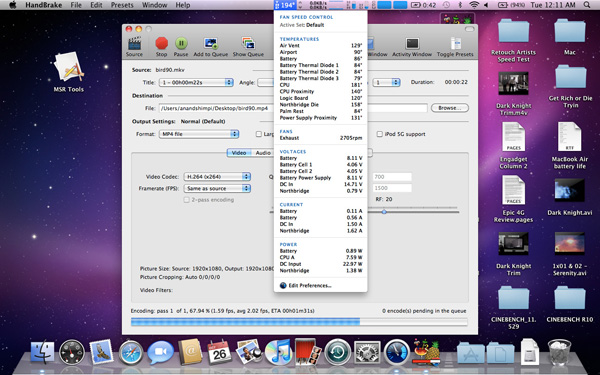
The 2008 MacBook Air under Load
Maximum temperature, at least reported by the MBA’s sensors, isn’t any lower on the new 13-inch than the 2008 I compared it to. Both CPUs hit roughly 84C (183F) under full load. But look at what happens to the chips after a minute at that load:
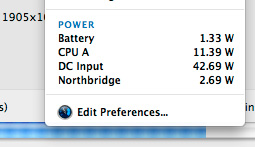 2010 13-inch MacBook Air |
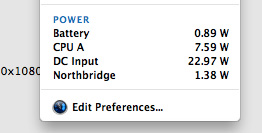 2008 13-inch MacBook Air |
iStat Menus reports the 1.86GHz Core 2 Duo in the 2008 system consuming only 7.59W, while the same CPU in the 2010 machine is drawing 11.45W. The 2008 machine is throttling back to reduce overall temperature while the 2010 system keeps going.
As a result, even the 11-inch MacBook Air will probably end up being as fast, if not faster than the 2nd generation 2008 13-inch MacBook Air. And our performance results confirm that:
| 11-inch MacBook Air (2010) vs. 13-inch MacBook Air (2008) | ||||||||
| Application Launch Test | Adobe Photoshop CS4 | Aperture RAW Import | Cinebench R10 - 1CPU | Cinebench R10 - XCPU | Quicktime H.264 Transcode | |||
| Apple 11-inch MacBook Air (2010) - 1.4GHz Core 2 Duo | 27.8 seconds | 72.4 seconds | 1.29 PPS | 1612 | 2967 | 33.1 fps | ||
| Apple 13-inch MacBook Air (2008) - 1.86GHz Core 2 Duo | 26.4 seconds | 71.3 seconds | 1.20 PPS | 2046 | 2882 | 30.1 fps | ||
You'll notice the less CPU intensive tasks are quicker on the old 13-inch system as the CPU isn't able to get hot enough to trigger Apple's throttling. The single threaded Cinebench test is the best example of this. The 26% performance advantage jibes with the 33% increase in CPU clock speed (it's actually a little low, most likely because the old CPU still isn't running at full speed even in this test). But now look at the heavier tests - the multithreaded Cinebench test and the Quicktime encode. Both of these stress both cores and drive TDP up, which forces Apple to pull clock speed back down. We wondered how Apple was able to cram such a high speed CPU into such a thin chassis as early as it did, now we know.
In practice I found the 2008 13-inch MBA launched applications quicker (short bursts of full clock speed), but after prolonged use or completing CPU intensive tasks it was tough to tell apart from the new 11-inch. What's even more troublesome is that Apple's aggressive clock throttling went relatively undetected until now. This is something I'm going to have to devise tests for and pay more attention to in future reviews. Sneaky, Steve, sneaky.
External Temperatures and Noise
The old MacBook Air chassis had a few dozen slits cut out of the aluminum for ventilation. The new MacBook Air chassis hides the ventilation slits between the base of the unit and the hinge. You can’t see them, but they’re there.
The slits are smaller than they were on the old chassis, which means moving air through them at the same rate sounds louder than before.
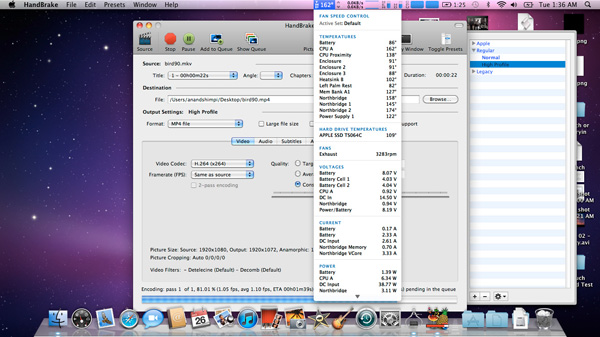
The 11-inch MacBook Air under Load
The CPU in the 11-inch model, even when under heavy loads, likes to stay at or below 72C (162F). At that temperature, the internal fan doesn’t spin above 4000 RPM (usually down below 3400). The 13-inch MacBook Air however is far more likely to generate noise. Running our simple Handbrake test the CPU will peak at over 82C (~180F) and the system’s internal fan will ramp up to over 6K RPM to compensate. Not only does the chassis get hot, but the fan gets audible. It’s still too small of a fan to really be considered loud in the grand scheme of things, but it’s loud enough to be annoying.
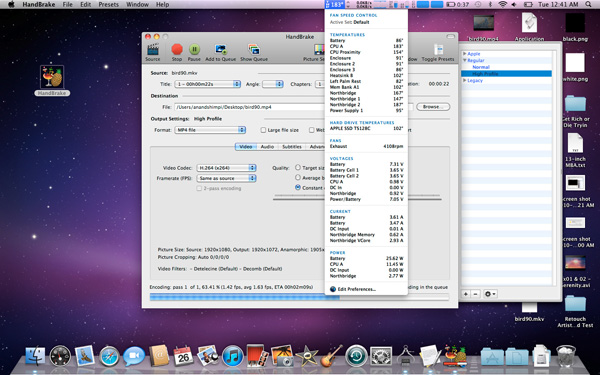
The 13-inch Macbook Air under Load
The surface temperature of the new 13-inch MacBook Air easily gets as high as the 2008 model. I measured a peak of 38.9C (102F) on both the 2008 and 2010 13-inch models. The 11-inch never broke 38C (100F).
Even casual use can ramp up temperatures pretty quickly. Just having a few websites open in the background that use Flash or other CPU intensive elements can slowly cause the MBA’s internal temperatures to rise. And now you’re beginning to see why Apple doesn’t install Flash on these things by default.
The danger zone is the upper left corner of the system, near the hinge. There’s only a single fan that cools both the CPU and GPU in the Air’s very tight enclosure. This is where that fan sits.










185 Comments
View All Comments
dsee15 - Wednesday, October 27, 2010 - link
Great thanks. Until then as a technical site, does anyone have a sense what the faster proc and additional 2GB mem do to performance? For example, it should run 20% faster for cpu intense apps, etc.Shadowmaster625 - Wednesday, October 27, 2010 - link
Well if you're spending money on any of these crapple concraptions then you are either not being productive or simply getting paid too much. Like those retired public employees who get paid 6 figure pensions for doing nothing. I dont know when that crap will stop, but I imagine it will be at around the same time apple flirts with bankruptcy.michael2k - Wednesday, October 27, 2010 - link
They have more cash than Microsoft. So after Microsoft flirts with bankruptcy?Shadowmaster625 - Wednesday, October 27, 2010 - link
They do have a lot of cash. But I can easily see them burning up half of it buying back their own stock once it starts tanking. And the other half could be burned up by just one or two flops. And that can easily happen once most apple lovers realize we are in fact in a depression and there is just no place for a company like apple in a depression.ShepherdH - Wednesday, October 27, 2010 - link
they just gave you more RAM and a larger hard drive at them. Same with most other Apple products.iwodo - Wednesday, October 27, 2010 - link
When Apple gets SandyBridge, i suspect 32nm, SandyBridge 1.8Ghz could do so within the same 1.4Ghz C2D Power envelop. But will be much more powerful. The only trouble is Apple wants CPU to be CPU, not a CPU with GPU built in.khimera2000 - Wednesday, October 27, 2010 - link
im not sure about that. they might just be looking for a sweet spot with CPU and GPU performance. in which case AMD's APU chips should be an intresting prospect since it gives you modern architecture on both sides in one chip.where intel took two dies and just slaped them together,AMD made it so the CPU and GPU can actualy talk to each other, also if AMD is to be beleaved this core would be retasked in the presance of another AMD card so the video chip on the CPU dosent become dead weight like the intel solution which just shuts down entirely in the presence of another card. (at least thats what i read)
personaly i think apple should get back into building there own hardware just like the g4 days. but that would require building there own OS, and seeing as mac hasent built an OS from the ground up for a long time (last time being os9? check out something called OpenStep) it might not be in there best intrest with win 7 getting so much traction and the failings of there previous Operating Systems it might not be good for the company to build something there not good at creating.
khimera2000 - Wednesday, October 27, 2010 - link
actually i dont think thats the case. there looking for a balanced system, and to this day intel has not released anything that can run a modern title (that i know of) if intel had a half way descent architecture on there vid cards i could see apple using it.however as things stand intel does not have a descent processer, and thats the reason why they have to use an nvidia video card. being that these notebooks use intergrated memory i can see that apple is looking for a specific perfomance point for there systems.
with that in mind i dont see why they wouldent consider AMD's soon to releas offerings. these chips has better gpu/cpu intergration then intel's options and sports the latest DX11 video architecture AMD has. I dont think theres anything in intel's arsinal that would be able to but heads with these chips from a graphic stand point, the only rogue facter in this is the new CPU architecture, since it has to yet be released.
Speaking of which... when can we expect to see reviews of the amd APU offerings from Anand? i would love to see how well it ticks, and a review to better define what makes it so differant from the intel chips that are comming out... perhaps an architetual comparison sometime in the future???
khimera2000 - Wednesday, October 27, 2010 - link
wow... i didnt know my first post went through for this response.. sorry about that. my connection hickuped. Love the sight keep up the good work :Dblufire - Wednesday, October 27, 2010 - link
You stated that the software restore drive is not write-protected, but Apple states that it is read-only. Who's right?http://support.apple.com/kb/HT4399
Thanks for the review!